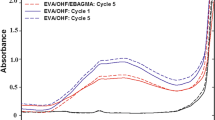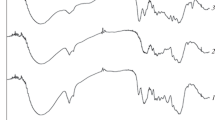Abstract
Our work is focused on the development of poly(3-hydroxybutyrate-co-3-hydroxyvalerate) (PHBV) composite materials loaded with olive husk flour (OHF) to solve the problem of compatibility between the hydrophobic polymer matrix and the hydrophilic fibre. A maleic anhydride (MA) modifying agent was used, which was grafted onto the polymer using a screw extruder. The efficiency of the grafting reaction of maleic anhydride on the macromolecular chains of PHBV with the rates of 0.73% for 1% MA and 0.3% for 3% MA was calculated using a titration method. The results showed that the mechanical properties of the PHBV/OHF bio-composites decreased considerably with increased modulus due to the poor interfacial adhesion between PHBV and OHF. The contribution of the modifying agent was undeniable, cohesion significantly improved and the mechanical properties also increased. The thermal properties showed that the degree of crystallinity of the composites decreases after the addition of a modifying agent. However, in view of the results, better adhesion to the interface is achieved with the use of 1% modifying agent (MA).






Similar content being viewed by others
References
Kumar V, Dev A, Gupta AP (2013) Synthesis of chain extended lactic acid/polypropylene glycol co-polymer. J Mater Environ Sci 4:828–831
Bordes P, Pollet E, Avérous L (2009) Nano-biocomposites: biodegradable polyester/nanoclay systems. Prog Polym Sci 34:125–155
Shilpi K, Ashok KS (2005) Recent advances in microbial polyhydroxyalkanoates. Polym Biochem 40:607–619
Abed RM, Dobretsov S, Sudesh K (2009) Applications of cyanobacteria in biotechnology. J Appl Microbiol 106:1–12
Sudesh K, Abe H, Doi Y (2000) Synthesis, structure and properties of polyhydroxyalkanoates: biological polyesters. Prog Polym Sci 25:1503–1555
Chardron S, Bruzaud B, Lignot B et al (2010) Characterization of bionanocomposites based on medium chain length polyhydroxyalkanoates synthesized by Pseudomonas oleovorans. Polym Test 29:966–971
Rutkowska M, Krasowska K, Heimowska A et al (2008) Environmental degradation of blends of atactic poly[(R, S)-3-hydroxybutyrate) with natural PHBV in Baltic sea water and compost with activated sludge. J Polym Environ 16:183–191
Vu CM, Sinh LH, Pham LT et al (2018) Preparation and physical characteristics of epoxy resin/bacterial cellulose biocomposites. Polym Bull 75:2607–2625
Vu CM, Sinh LH, Nguyen DD et al (2018) Micro-fibril cellulose as a filler for glass fiber reinforced unsaturated polyester composites: fabrication and mechanical characteristics. Macromol Res 26:54–60
Bourmaud A, Baley C (2007) Investigations on the recycling of hemp and sisal fiber reinforced polypropylene composites. Polym Degrad Stab 92:1034–1045
Liu XY, Dai GC (2007) Surface modification and micromechanical properties of jute fiber mat reinforced polypropylene composites. Exp Polym Lett 1:299–307
Bessadok A, Marais S, Roudesli S et al (2007) Comportement à l’eau des fibres alfa et agave modifiées chimiquement. Compos Sci Technol 67:685–697
Beaugrand J, Berzin F (2013) Lignocellulosic fiber reinforced composites: influence of compounding conditions on defibrization and mechanical properties. J Appl Polym Sci 128:1227–1238
Vu CM, Sinh LH, Choi HJ et al (2017) Effect of micro/nano white bamboo fibrils on physical characteristics of epoxy resin reinforced composites. Cellulose 24:5475–5486
Tserki V, Zafeiropoulosb NE, Simonb F et al (2005) A study of the effect of acetylation and propionylation surface treatments on natural fibres. Compos A 36:1110–1118
Zafeiropoulos NE, Willians DR, Baillie CA et al (2002) Engineering and characterization of the interface in flaxe fibre/polypropylene composite materials part I development and investigation of surface treatements. Compos A 33:1083–1093
Bledzki AK, Mamun AA, Lucka-Gabor M et al (2008) The effects of acetylation on properties of flax fibre and its polypropylene composites. Exp Polym Lett 2:413–422
Vu CM, Le Hoang S, Nguyen DD et al (2018) Improvement the mode I interlaminar fracture toughness of glass fiber reinforced phenolic resin by using epoxidized soybean oil. Polym Bull 75:4769–4782
Kaci M, Djidjelli H, Boukerrou A et al (2007) Effect of wood filler treatement and EBAGMA compatibilizer on morphology and mechanical properties of low-density polyethylene/olive husk flour composites. Exp Polym Lett 1:467–473
Boukerrou A, Krim S, Djidjelli H et al (2011) Study and characterization of composites materials based on polypropylene loaded with olive husk flour. J Appl Polym Sci 122:1382–1394
Dominkovics Z, Danyadi L, Pukanszky B (2007) Surface modification of wood flour and its effect on the properties of PP/wood composites. Compos A 38:1893–1901
Nabar Y, Raquez JM, Dubois P et al (2005) Production of starch foams by twin-screw extrusion: effect of maleated poly(butylene adipate-co-terephthalate) as a compatibilizer. Biomacromolecules 6:807–817
Rosa D, Lotto N, Lopes D et al (2004) The use of roughness for evaluating the biodegradation of poly-β-(hydroxybutyrate) and poly-β-(hydroxybutyrate-co-β- valerate). Polym Test 23:3–8
Lim LT, Auras R, Rubino M (2008) Processing technologies for poly(lactic acid). Prog Polym Sci 33:820–852
Yanming C, Jungang L, Jimin F (2013) Spectral characterization of four kinds of biodegradable plastics: poly (lactic acid), poly (butylenes adipate-co-terephthalate), poly (hydroxybutyrate-co-hydroxyvalerate) and poly (butylenes succinate) with FTIR and Raman spectroscopy. J Polym Environ 21:108–114
Li Q, Matuana L (2003) Surface of cellulosic materials modified with functionalized PE coupling agents. J Appl Polym Sci 88:278–286
Kazayahoko M, Balatinecz JJ, Matuana LM (1999) Surface modification and adhesion mechanisms in wood fiber-polypropylene composites. J Mater Sci 34:6189–6199
Cui Y, Lee S, Noruziaan B (2008) Fabrication and interfacial modification of wood/recycled plastic composite materials. Compos A 39:655–661
Piming M, Denka G, Hristova B et al (2012) Reactive compatibilization of ethylene-co-vinyl acetate/starch blends. Macromol Res 20:1054–1062
Ashori A, Sheshmani S (2010) Hybrid composites made from recycled materials: moisture absorption and thickness swelling behavior. Bioresour Technol 101:4717–4720
Demir H, Atikler U, Balkose D et al (2006) The effect of fiber surface treatments on the tensile and water sorption properties of polypropylene–luffa fiber composites. Compos A 37:447–456
Yang HS, Kim HJ, Park HJ et al (2006) Water absorption behavior and mechanical properties of lignocellulosic filler–polyolefin bio-composites. Compos Struct 72:429–437
Nachtigall SMB, Cerveira GS, Rosa SML (2007) New polymeric-coupling agent for polypropylene/wood-flour composites. Polym Test 26:619–628
Adhikary KB, Pang S, Staiger MP (2008) Long-term moisture absorption and thickness swelling behaviour of recycled thermoplastics reinforced with Pinus radiata sawdust. Chem Eng J 142:190–198
Ichazo MN, Albano C, González J et al (2001) Polypropylene/wood flour composites: treatments and properties. Compos Struct 54:207–214
Arib RMN, Sapuan SM, Ahmad MMHM et al (2006) Mechanical properties of pineapple leaf fibre reinforced polypropylene composites. Mater Des 27:391–396
Khalid M, Ratnam CT, Chuah TG et al (2008) Comparative study of polypropylene composites reinforced with oil palm empty fruit bunch fiber and oil palm derived cellulose. Mater Des 29:173–178
Maya JJ, Bejoy F, Varughese KT et al (2008) Effect of Chemical modification on properties of hybrid fiber biocomposite. Compos Part A 39:352–363
Kim HS, Kim S, Kim HJ et al (2006) Thermal properties of bio-flour-filled polyolefin composites with different compatibilizing agent type and content. Thermochim Acta 451:181–188
Javadi A, Srithep Y, Pilla S et al (2010) Processing and characterization of solid and microcellular PHBV/coir fiber composites. Mater Sci Eng 30:749–757
Jiang L, Huang J, Qian J et al (2008) Study of poly(3-hydroxybutyrate-co-3-hydroxyvalerate) (PHBV)/bamboo pulp fiber composites: effects of nucleation agent and compatibilizer. J Polym Environ 16:83–93
Abdelwahab MA, Flynn A, Chiou B-S et al (2012) Thermal, mechanical and morphological characterization of plasticized PLA–PHB blends. Polym Degrad Stab 97:1822–1828
Gunaratne LM, Shanks RA, Amarasinghe G (2004) Thermal history effects on crystallisation and melting of poly(3-hydroxybutyrate). Thermochim Acta 423:127–135
Singh S, Mohanty AK, Sugie T et al (2008) Renewable resource based biocomposites from natural fiber and polyhydroxybutyrate-co-valerate (PHBV) bioplastic. Compos A 39:875–886
Rahman MR, Huque MM, Islam MN et al (2009) Mechanical properties of polypropylene composites reinforced with chemically treated abaca. Compos A 40:511–517
Hammiche D, Boukerrou A, Djidjelli H et al (2012) Synthesis of a new compatibilisant agent PVC-g-MA and its use in the PVC/alfa composites. J Appl Polym Sci 124:4352–4361
Metin D, Tihminlioğlu F, Balköse D et al (2004) The effect of interfacial interactions on the mechanical properties of polypropylene/natural zeolite composites. Compos A 35:23–32
Ku H, Wang H, Pattarachaiyakoop N et al (2011) A review on the tensile properties of natural fiber reinforced polymer composites. Compos B 42:856–873
Karmarkar A, Chauhan SS, Jayant M et al (2007) Mechanical properties of wood–fiber reinforced polypropylene composites: effect of a novel compatibilizer with isocyanate functional group. Compos A 38:227–233
De laOrden MU, González Sánchez C, González Quesada M et al (2007) Novel polypropylene-cellulose composites using polyethylenimine as coupling agent. Compos A 38:2005–2012
Acknowledgements
The authors thank the University of Bejaia (Algeria) for its financial assistance with Noura Hamour’s travelling expenses. The authors are also pleased to acknowledge thank the CATEL Company for their help and for the use of the tensile testing facility.
Author information
Authors and Affiliations
Corresponding author
Additional information
Publisher's Note
Springer Nature remains neutral with regard to jurisdictional claims in published maps and institutional affiliations.
Rights and permissions
About this article
Cite this article
Hamour, N., Boukerrou, A., Djidjelli, H. et al. In situ grafting effect of a coupling agent on different properties of a poly(3-hydroxybutyrate-co-3-hydroxyvalerate)/olive husk flour composite. Polym. Bull. 76, 6275–6290 (2019). https://doi.org/10.1007/s00289-019-02725-y
Received:
Revised:
Accepted:
Published:
Issue Date:
DOI: https://doi.org/10.1007/s00289-019-02725-y




